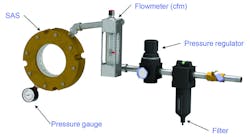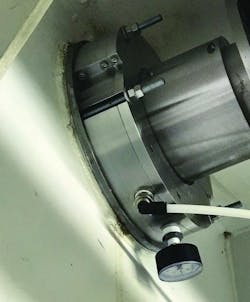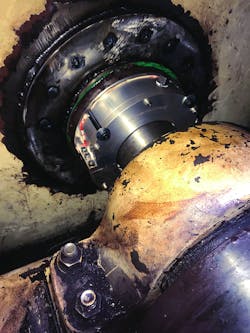Dry powder handling machines, by their nature, are difficult to seal. The traditional method is to use either packing, air purge seals, or in-face and other mechanical seals.
With all these methods, the product contacts the sealing element and leads to accelerated wear of the sealing components and the shaft/sleeve of the machine. Excessive wear leads to product loss and higher overall operating costs. Another challenge in sealing dry powder equipment is that many of the vessels are fabricated, and the seal must mount against the wall of the vessel, which may be perpendicular to the shaft.
An air seal, such as the SEPCO Air Seal (SAS), is designed to accommodate up to 1.5 degrees of misalignment, conditions that are difficult, in some cases, to seal effectively. When packing is used, it may stabilize the shaft, but depending on the service and operating conditions, it will also fret the shaft or sleeve to a point where the product is no longer sealed and it ends up on the floor. Also, air seals have been successfully used in wet applications, such as hydro pulpers, agitators, mixers and slurry pumps.
Figure 2. Air purge schematic
How they work
Air seals use engineered clearances and directional flow paths to create uniform pressure and velocity profiles that generate a pneumatic seal (see Figure 2). To accommodate the inherent misalignment that may be present in many of the services in which this technology is applied, a floating throttle is used that is capable of handling 0.0625 inch parallel and 1.5 degrees of angular misalignment. By controlling the internal pressure/flow profile circumferential, a boundary layer of air is formed between the throttle and the shaft/sleeve mitigating damage that would occur due to mechanical runout by allowing the throttle to float on the boundary layer.
Figure 3. An air seal installed on a mixer combining dry ingredients at a bread bakery
Installation
The air seal comes in solid and split configurations and is designed for ease of installation. Proper installation of the seal is achieved by using spacers that dictate the gap between the seal housing and the shaft. The throttle floats and no adjustment is required on installation. Adequate air supply and auxiliary hardware must be installed as shown in Figure 2 for each individual seal. Startup of the system is predicated on the air being turned on at least 1 minute prior to product being introduced to the machine, this ensures the seal body is at the required pressure setting.
No maintenance required
These air seals require no maintenance as long as air flows continuously to the seal. By design, product will not enter the seal or throttle area, which eliminates the need for maintenance. Its material of construction keeps wear and corrosion from occurring. However, system upsets occur, and if product enters, the seal can be easily disassembled, cleaned and reassembled.
If the air supply is turned off during operation and with product introduced, the product may enter the seal. This will lead to the internal air passageway becoming clogged, disrupting the uniformity of the pressure profile. Should this happen, seal disassembly may be required. The seal is simple and can be easily rebuilt, but contact the manufacturer if this occurs.
Difficult-to-seal applications
Powders and bulk solids are transported and handled in many industries. These include pulp and paper, chemical, pharmaceutical and food and beverage. Specific applications in the pulp and paper and food industries are detailed in this section.
Figure 4. An air seal installed on a chocolate mixer
Pulp and paper industry
Operations in the paper industry are harsh and involve the movement of bulk solids through many steps of the process. The pulpers, agitators and mixers in the mill are large and often difficult to seal. Often, they are filled from the bottom, and leakage is nearly universal. Until recently, packing was used with leakage being allowed to occur or mechanical seals were used and repaired or replaced when they failed because of the solids involved in the pulping process.
However, air seals are changing these inefficient methods. One air seal installed in a paper plant solved a problem that the reliability engineer thought was unsolvable. The pulper in question had been a bad actor for years. When the air seal was installed, operation became normal and completely leak-free. The end user has saved time and money on maintenance, seal repairs and replacements, and wasted product.
Food industry
Bread production is a huge industry, and combining the dry ingredients used in the process is challenging. One bread manufacturer experienced significant leakage of dry bread ingredients from its mixers. This leaking caused:
- Product loss
- Premature bearing failure
- Housekeeping problems
- Frequent packing replacement
- Shaft wear from the packing
- Liability issues related to safety
When the air seals were installed on the mixers that combined the dry ingredients, the following advantages were achieved:
- Maintenance of equipment and premature bearing failure decreased
- Product remained in the mixer and not on the floor
- Money was saved on labor hours, product and component replacement
- Safety issues were mitigated
Another challenging industry is chocolate production. Sealing mixers that blend and refine chocolate has long been a struggle for chocolatiers. One chocolate company was losing up to $2 million in chocolate from product leakage each year. After installing an air seal, the leakage was eliminated, and the end user was able to save the $2 million.
Conclusion
Developments in air sealing technology allow end users to experience a dramatic reduction in operational costs of the machine because of the mitigation of maintenance, repair and clean up as well as the elimination of product loss.
Woody Nepa, engineer, Product Development and Reliability Solutions, Sealing Equipment Products Co. Inc. (SEPCO), spent 15 years as the manager of Aftermarket Engineering with Goulds Pumps and 12 years as a regional manager with Inpro/Seal. The focus of his career has been on rotating equipment reliability. Nepa received a Bachelor of Science in Mechanical Engineering (BSME) from the Rochester Institute of Technology.
Mikal Hayes is an applications engineer for SEPCO and a member of the Processing Editorial Advisory Board. Hayes’ roles include designing, analyzing and testing new mechanical seals, bearing isolators and air seals — with a focus on product research and development. Hayes received his BSME from the University of Alabama at Birmingham (UAB).
For more information about SEPCO seals, email [email protected].





